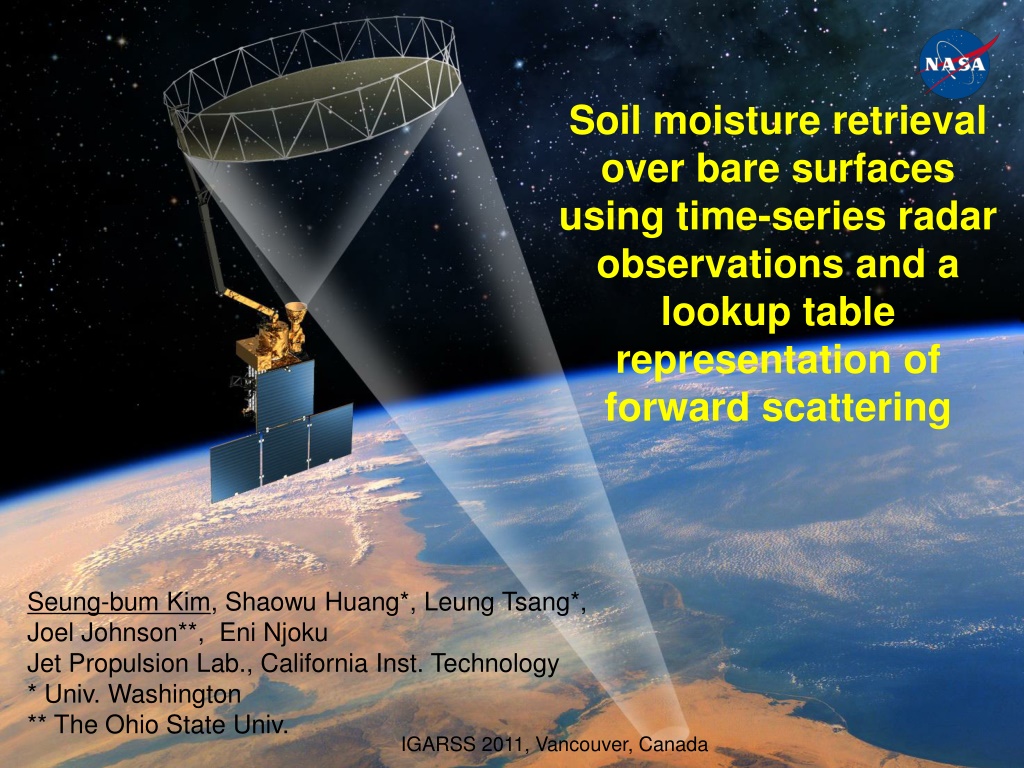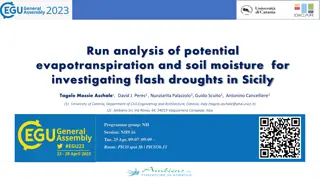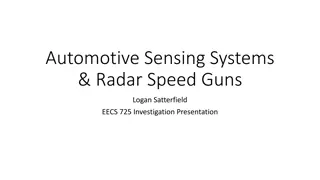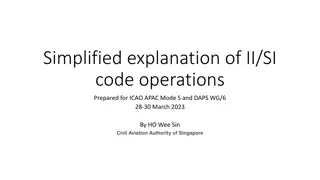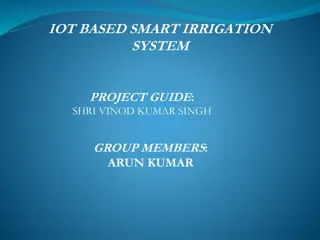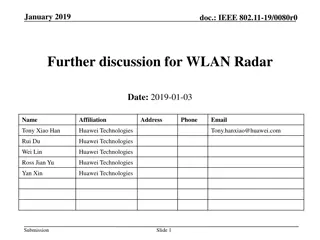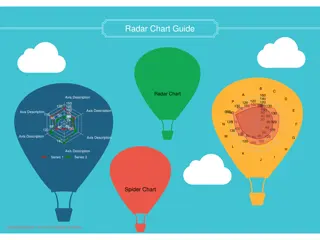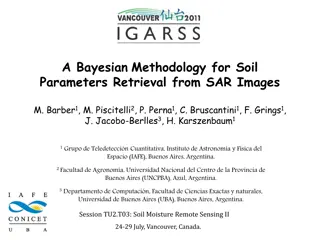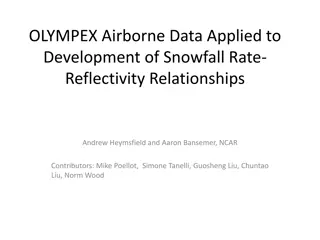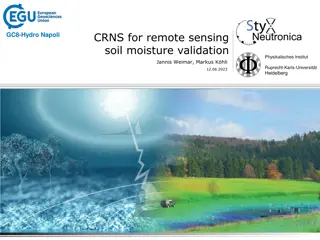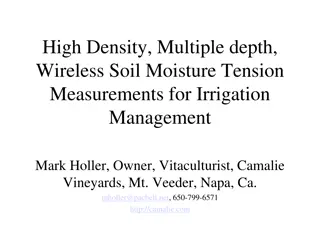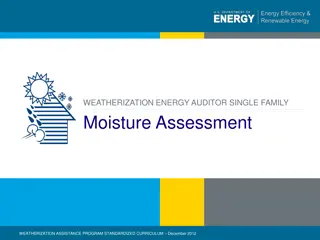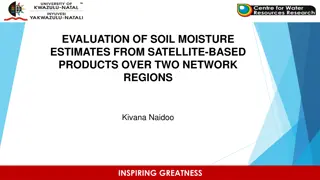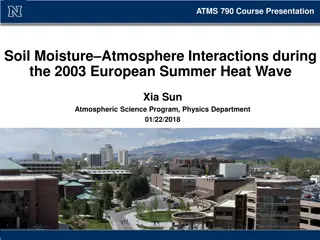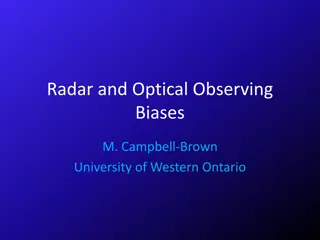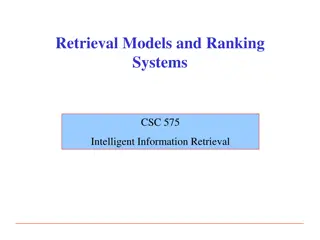Soil Moisture Retrieval Over Bare Surfaces Using Radar Observations
This study focuses on retrieving soil moisture over bare surfaces using radar observations and a lookup table representation of forward scattering. The research aims to develop a non-empirical and simple method for accurate soil moisture retrieval without the need for ancillary information. Issues with bare surface soil moisture retrieval, such as ambiguity and errors in parameter estimation, are discussed. The soil moisture retrieval method involves a forward model that is inverted using a lookup table representation, showing promising results compared to in-situ datasets.
Uploaded on Sep 19, 2024 | 0 Views
Download Presentation

Please find below an Image/Link to download the presentation.
The content on the website is provided AS IS for your information and personal use only. It may not be sold, licensed, or shared on other websites without obtaining consent from the author. Download presentation by click this link. If you encounter any issues during the download, it is possible that the publisher has removed the file from their server.
E N D
Presentation Transcript
Soil moisture retrieval over bare surfaces using time-series radar observations and a lookup table representation of forward scattering Seung-bum Kim, Shaowu Huang*, Leung Tsang*, Joel Johnson**, Eni Njoku Jet Propulsion Lab., California Inst. Technology * Univ. Washington ** The Ohio State Univ. IGARSS 2011, Vancouver, Canada
Objectives A bare and sparsely vegetation surface covers 13% of the world s land surface. Over vegetated surfaces, a soil moisture signal comes from the bare surface. Accurate soil moisture retrieval over the bare surface forms the basis of global soil moisture retrieval We focus on the soil surface where the roughness has the isotropic random distribution. We study the retrieval of soil moisture at L-band at 40deg incidence angle to apply to the Soil Moisture Active Passive (SMAP) mission NASA s SMAP mission Global, high-resolution mapping of soil moisture (top 5cm) and its freeze/thaw state Three year mission, due for launch in 2015 1000 km-wide swath, enabling 2 3 day revisit Retrievals with radiometer (36km resolution), SAR (3km), and SAR/radiometer combined (9km) Multi-pol (HH, VV, HV) To achieve the global coverage, the number of single looks was compromised (60, worst case), leading to somewhat large speckle. Total radar measurement error ranges from 0.5dB (13%) to 0.7dB (17%) IGARSS 2011 S.B. Kim - 1 -
Issues with bare surface soil moisture retrieval Four parameters dominating the radar scattering from bare surface: surface roughness (s), soil moisture (Mv), correlation length of roughness (l), correlation function (F) Issues to resolve for accurate soil moisture retrieval With HH, VV, HV, we cannot determine all 4 unknowns Knowledge of correlation length and function is very inaccurate (50% error). Ambiguity: dry & rough soil 0 ~ wet & smooth soil simga0 can lead to multiple solutions 13% to 17% radar measurement error Past literature Empirical retrieval model without considering l or F (Oh et al. 1992; Dubois et al. 1995) The exponential function fits data well (Shi et al. 1997; Mattia et al. 1997) Estimate s and l after assuming temporally static Using ancillary dry condition (Rahman et al. 2008) Using one time measurement (Joseph 2008) Statistical estimate (Verhoest et al. 2007) Using ancillary weather model (Mattia et al. 2009) Eliminate s during retrieval (Shi et al. 1997) Our goal: develop non-empirical and simple method that does not need ancillary information IGARSS 2011 S.B. Kim - 2 -
Soil moisture retrieval method A forward model (Numerical Maxwell Model in 3-Dimension, NMM3D, Huang et al. 2010; 2011) is inverted using its lookup table representation. The NMM3D computes numerical solutions of Maxwell s equations without approximate parameterizations or tuning. The NMM3D predictions compare well with in situ datasets representing wide ranges of roughness, soil moisture, and correlation length. rmse=1.49dB (VV) 1.64dB (HH) Huang, Tsang, Njoku, Chen, TGRS, 2010 Results with correlation length/rms height (l/s) =4,7,10 is also available. IGARSS 2011 S.B. Kim - 3 -
Retrieval with a lookup table The retrieval based on a lookup table performs better. In comparison, the inversion of a sophisticated model (IEM) is not as accurate. 10log shh= -20.17+15.33mv+13.63log ks 10log svv= -18.81+25.33mv+10.99log ks ( ) ( ) Lookup table RMS Error = 0.0016 cm3/cm3 Parameterized IEM based on 3 Mv and 3 ks simulations RMS Error = 0.0067 cm3/cm3 Courtesy: J.J. van Zyl IGARSS 2011 S.B. Kim - 4 -
Soil moisture retrieval method ( ( ) ) ( ) C s,er1,er2,..,erN ( ) = w1,HHsHH t1 ( )-sHH,LUT t2 ( )-sHH,LUT ( ) t1 ( )-sVV,LUT t2 ( )-sVV,LUT ( ) 2+ w1,VVsVV ) 2 s,er1 ( s,er1 ( 0 0 0 0 ( ) ) 2+ w2,VVsVV 2 +w2,HHsHH +... s,er2 s,er2 0 0 0 0 ( ( ) ( ) ( )-sHH,LUT ( ) ( )-sVV,LUT ( ) 2+ w1,VVsVV ( 2 +wN,HHsHH =1 N[E1sHH +ENsHH s,erN )+ E2sHH )] s,erN 0 0 0 0 tN tN )+... t1 ( ),sVV ( ),sVV t1 ( ),s,er1 ( ),s,erN t2 ( ),sVV t2 ( ),s,er2 0 0 0 0 ( 0 0 tN tN Two-polarization (HH and VV) are used for input. HV channel is set aside for vegetation information for future. Mv and roughness are retrieved. 2N independent input (HH and VV, N is the number of time-series) N+1 unknowns assuming roughness does not change in time. The retrieval of the soil moisture is accomplished by the least square minimization. Time-invariant roughness is estimated first. Then time-varying soil moisture is retrieved. IGARSS 2011 S.B. Kim - 5 -
Monte-Carlo simulation Time-series search of lookup table The radar measurement noise (0.7dB, 17%) is modeled by a Gaussian random process. Errors in roughness estimate is smaller than 10%. Real part of the dielectric constant ( r) is retrieved first and Mv error is smaller than 0.06 cm3/cm3. Snap-shot search of lookup table A snapshot search of the same lookup table has no constraint on roughness, is subject to the ambiguity, and the rmse is very large. IGARSS 2011 S.B. Kim - 6 -
Validation with in situ data Truck-mounted radar measurements in Ypsilanti, Michigan were obtained over a two-month campaign (Oh et al. 2002). The LUT time-series and snap-shot performs comparably most likely because the radar measurement error (~0.4dB) is smaller than 0.7dB. Dubois method has outliers. IGARSS 2011 S.B. Kim - 7 -
Validation with in situ data LUT snapshot LUT time-series The retrievals from all 4 sites are combined in one scatter plot. Many retrievals of the Dubois retrieval become outliers. Overall the LUT time-series retrieval shows the best correlation with the in situ mv and the best rmse in soil moisture estimation. 0.4 0.4 rmse=0.055 corr=0.82 rmse=0.044 corr=0.89 retrieval (cm3/cm3) retrieval (cm3/cm3) 0.3 0.3 0.2 0.2 0.1 0.1 mean_e=0.006 mean_e=0.013 0.0 0.0 0.0 0.1 in situ (cm3/cm3) 0.2 0.3 0.4 0.0 0.1 in situ (cm3/cm3) 0.2 0.3 0.4 Dubois Relative change index 1.0 0.4 rmse > 1 corr= -0.14 retrieval (cm3/cm3) 0.3 0.8 0.6 index 0.2 0.4 0.1 0.2 corr=0.80 mean_e > 1 0.0 0.0 0.0 0.1 in situ (cm3/cm3) 0.2 0.3 0.4 0.0 0.1 in situ (cm3/cm3) 0.2 0.3 0.4 IGARSS 2011 S.B. Kim - 8 -
Effects of correlation length The validation with the Michigan data is performed: (a) uses l (correlation length) / s (rms height) of 10 (= the same as forward model). (b) uses the truth. The choice of l/s does not affect the Mv retrieval. Site (rms hgt) l/s =4 l/s = 7 1 (0.55cm) 0.037 0.041 2 (0.94cm) 0.043 0.048 (b) 3 (1.78cm) 0.043(b) 0.043 4 (3.47cm) 0.055(b) 0.042 l/s = 10 0.038(a) 0.051(a) 0.047(a) 0.040(a) l/s = 15 0.038(b) 0.048 0.055 0.042 Change of l/s merely adds a bias to the cost function +.. Even if the value of the cost function changes, the location of the minimum (=Mv retrieval) does not. Retrieved Mv IGARSS 2011 S.B. Kim - 9 -
Effects of correlation length If a single scattering process is dominant, the IEM shows that the roughness effect and the dielectric effect can be decoupled (Fung et al. 1992; Shi et al. 1997): 0 (Mv, s, l/s) = f(Mv) + g(s, l/s) Then 0 (Mv, s, l/s=a) - 0 (Mv, s, l/s= b ) = g(s, l/s=a) - g(s, l/s=b) = independent of Mv. l/s=4 l/s=15 The bias offset is uniform wrt dielectric constant and polarization. IGARSS 2011 S.B. Kim - 10 -
Summary Findings Time-invariant roughness and soil moisture are estimated using the time-series method (2N inputs solve N+1 unknowns). Does not require ancillary information. Simple search of a lookup table. Tested with in situ data: the error is 0.044 cm3/cm3 using 6-11 time-series inputs. The time-series method performs better than the other methods. Retrieval is mostly independent of the knowledge of correlation length one degree of freedom is reduced. Discussion Increase in time-series window will further reduce the radar measurement noise improve roughness estimate improve Mv retrieval. IGARSS 2011 S.B. Kim - 11 -
backup IGARSS 2011 S.B. Kim - 12 -
Soil moisture: retrieval performance IGARSS 2011 S.B. Kim - 13 -
